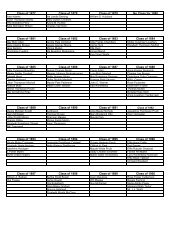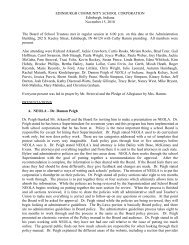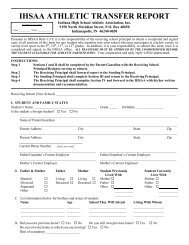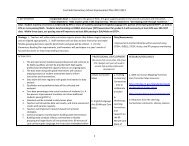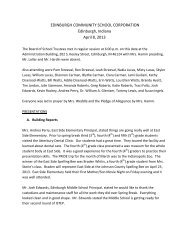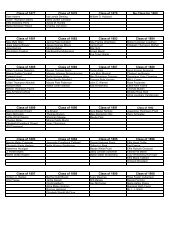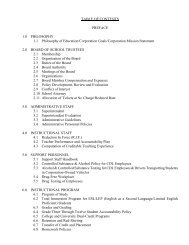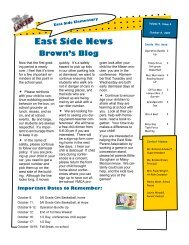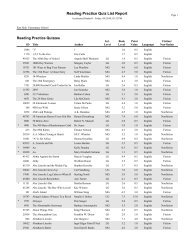Edinburgh Community High School - Edinburgh CSC
Edinburgh Community High School - Edinburgh CSC
Edinburgh Community High School - Edinburgh CSC
Create successful ePaper yourself
Turn your PDF publications into a flip-book with our unique Google optimized e-Paper software.
____________---<br />
<strong>Edinburgh</strong><br />
<strong>Community</strong><br />
<strong>High</strong> <strong>School</strong><br />
300 S. Keeley St.<br />
<strong>Edinburgh</strong>, IN 46124<br />
<strong>School</strong><br />
Improvement<br />
Plan<br />
May 2009
<strong>Edinburgh</strong> <strong>Community</strong> <strong>High</strong> <strong>School</strong><br />
<strong>School</strong> Improvement Plan<br />
May 2009<br />
Committee Members<br />
Kevin Rockey<br />
Traci Foltz<br />
Ginger Kahl<br />
Debbie <strong>High</strong>tshue<br />
Shaun Rosser<br />
David Bauman<br />
Derck Engelbert<br />
Lisa Chandler<br />
2
Table of Contents<br />
Mission. . . . . . . . . . . . . . . . . . . . . . . . . . . . . . . . . . . . . . . . . . . . . . . . . . . . . . . . . .4<br />
Philosophy. . . . . . . . . . . . . . . . . . . . . . . . . . . . . . . . . . . . . . . . . . . . . . . . . . . . . . .4<br />
Student Demographics and Performance. . . . . . . . . . . . . . . . . . . . . . . . . . . . .5-11<br />
Curriculum. . . . . . . . . . . . . . . . . . . . . . . . . . . . . . . . . . . . . . . . . . . . . . . . . . . . . . 12<br />
Student Participation ………………………………………………………………….12<br />
Parental Participation. . . . . . . . . . . . . . . . . . . . . . . . . . . . . . . . . . . . . . . . . . . . . .13<br />
Technology Department. . . . . . . . . . . . . . . . . . . . . . . . . . . . . . . . . . . . . . . . . . . 14<br />
Safe and Disciplined Learning Environment. . . . . . . . . . . . . . . . . . . . . . . . . . . . 15<br />
Assessments . . . . . . .. . . . . . . . . . . . . . . . . . . . . . . . . . . . . . . . . . . . . . . . ……16<br />
Professional Development. . . . . . . . . . . . . . . . . . . . . . . . . . . . . . . . . . . . . . . ….17<br />
Corporation Goals . . . . . . . . . . . . . . . . . . . . . . . . . . . . . . . . . . . . . . . . . . . . . 18-19<br />
Action Plan Goals and Interventions . . . . . . . . . . . . . . . . . . . . . . . . . . . . . . .20-22<br />
3
<strong>Edinburgh</strong> <strong>Community</strong> <strong>High</strong> <strong>School</strong><br />
<strong>School</strong> Improvement Plan<br />
2009-2010<br />
Motto<br />
Creating Our Legacy… Every Student, Every Day<br />
Mission Statement<br />
The <strong>Edinburgh</strong> <strong>High</strong> <strong>School</strong> <strong>Community</strong> will provide, within a safe and<br />
caring environment, programs which enable all students to realize<br />
their academic potential and to achieve personal wellness, as they<br />
develop into productive members of society.<br />
Philosophy<br />
<strong>Edinburgh</strong> <strong>Community</strong> <strong>High</strong> <strong>School</strong> strives to provide all students with<br />
opportunities and resources to fully develop their educational<br />
potential. With the support and partnership of all members of the<br />
school community, students can acquire the appropriate analytical<br />
skills and experiences to become productive and responsible citizens.<br />
4
STUDENT DEMOGRAPHICS AND PERFORMANCE<br />
<strong>Edinburgh</strong>, Indiana is located in the far southeast corner of Johnson County, and was<br />
the first settlement in the county. The community was laid out and platted in 1822.<br />
<strong>Edinburgh</strong> was at one time a great pork and grain center, as a result of the completion of<br />
the Madison-Indianapolis Railroad through <strong>Edinburgh</strong>.<br />
According to the 2000 census, the population of <strong>Edinburgh</strong> totals close to 4500<br />
individuals. The community is made up of mostly blue-collared workers. The 2000<br />
census revealed that 41% of the adult population does not possess high school<br />
diplomas and only 3% possesses a bachelor’s or advanced degree.<br />
<strong>Edinburgh</strong> <strong>Community</strong> <strong>High</strong> <strong>School</strong>’s comprehensive four-year educational program<br />
serves a student population of 276 students. Of this group, 97% are White, 2% are<br />
Hispanic and the remaining 1% is multi-racial. Free and reduced-price lunches are<br />
served to 42% of the students. Special needs students make up approximately 13% of<br />
the ECHS student body.<br />
The attendance rate for ECHS students for the 2007-2008 school year was 94.5%. We<br />
will continue to focus on our attendance rate with a goal to obtain the state average or<br />
higher. The local outlet mall provides employment for many of the ECHS students,<br />
including retail and food service jobs.<br />
5
Graduates of ECHS have the opportunity to earn a regular, Core 40, Technical<br />
Honors or Academic Honors diploma. In 2007, 76% of students earned Core 40<br />
diplomas or higher, with 26% earning Academic Honors diplomas. In 2008, 85%<br />
of students earned Core 40 diplomas or higher with 18% earning Academic<br />
Honors.<br />
6
Under a new calculation, the Indiana Department of Education recorded a<br />
graduation rate, or four year completion rate, for EHS of 75.9% for the 2005-2006<br />
school year and 64.0 % for the 2006-2007 school year.<br />
7
ISTEP+/GQE:<br />
ASSESSMENT PERFORMANCE<br />
As recorded by the Indiana Department of Education for the 2008-2009 GQE<br />
ISTEP+ test, 55%of the 10 th graders passed the Math standard, 59% passed the<br />
Language Arts standard, and 51% of the students passed both parts of the GQE.<br />
8
PSAT:<br />
9
SAT:<br />
10
AP Exams:<br />
11
CURRICULUM<br />
In order to address the unique needs, personal interests, and capabilities of each<br />
student, <strong>Edinburgh</strong> <strong>Community</strong> <strong>High</strong> <strong>School</strong> offers classes through the art,<br />
business, English, family and consumer sciences, foreign language, industrial<br />
technology, health and physical education, mathematics, music, science, social<br />
studies, and special education departments. Students are provided with services<br />
from a guidance department and with many student activities. Student interests<br />
and capabilities are also served through C4, College Prep, Honors English and<br />
AP class offerings.<br />
E<strong>CSC</strong> has adopted the Indiana Academic Standards as the written curriculum<br />
that provides natural K-12 alignment in all subject areas. Teachers develop<br />
course guides based upon the standards. A new <strong>High</strong> Ability curriculum was<br />
implemented for the 2008-2009 school year.<br />
The curriculum for <strong>Edinburgh</strong> <strong>Community</strong> <strong>High</strong> <strong>School</strong> is available for public<br />
perusal at the school corporation’s central office at 202 S. Keeley Street, or it<br />
may be accessed via the high school’s web page at www.ecsc.k12.in.us. A<br />
general description of all high school course offerings is provided in the Course<br />
Description Guide.<br />
STUDENT PARTICIPATION<br />
C4, the vocational school located in Columbus, Indiana offers opportunities for<br />
<strong>Edinburgh</strong> students to participate in extensive career and vocational training<br />
classes. The closer proximity of C4 to our school corporation provides the<br />
opportunity for more of our students to participate in the programs than in the<br />
past. Several C4 programs allow students to enroll in classes which lead to the<br />
attainment of certificates of technical achievement or dual credits for college.<br />
Articulation agreements have been approved with post-secondary institutions<br />
such as Ivy Tech and IUPUC.<br />
<strong>School</strong> activities for students include sports programs for both boys and girls<br />
during each sports season. In addition, curricular and co-curricular clubs for<br />
students include French and Spanish clubs, FCCLA, FCA, Chess Club, National<br />
Honor Society, Student Council, SADD, Philanthropy Club, Lancer yearbook, and<br />
Art club. Finally, the Renaissance Club recognizes students who have improved<br />
in a particular subject, demonstrated outstanding performance, achieved perfect<br />
attendance, or attained honor roll status. With the ongoing support of parents,<br />
teachers, support staff, administrators, and community patrons, <strong>Edinburgh</strong><br />
<strong>Community</strong> <strong>High</strong> <strong>School</strong> will continue to become a high school which prepares its<br />
students for post-secondary success.<br />
12
PARENTAL PARTICIPATION<br />
<strong>Edinburgh</strong> <strong>Community</strong> <strong>High</strong> <strong>School</strong> offers many opportunities for parent and<br />
community involvement. Parents and community members are encouraged to<br />
take part in the educational process. The HS/MS Boosters sponsor school<br />
activities, raise funds for school organizations and work at the concession<br />
stands. This organization supports classroom activities through monetary<br />
donations to be used for purchase of classroom supplies as well as extracurricular<br />
activities. Band Boosters support the high school band program by<br />
raising funds for equipment and field trips as well as the new marching band<br />
uniforms for the 2008-2009 season.<br />
Parents and community members are encouraged to serve on committees such<br />
as the After Prom, <strong>School</strong> Improvement, Alternative Education and <strong>High</strong> Ability<br />
committees. Other opportunities for their involvement include serving as a guest<br />
speaker for a class lecture, coaching and supporting athletics, attending<br />
conferences, or visiting the school.<br />
As their child’s first teachers, parents play valuable roles in supporting education.<br />
They do this by assisting with homework or class assignments, talking with their<br />
children about school, attending school functions, and participating in parent and<br />
teacher conferences. In an effort to improve parent participation in these vital<br />
areas, the school has initiated the Parent Connect website for parents to<br />
frequently monitor their student’s grades, discipline and attendance.<br />
13
TECHNOLOGY DEPARTMENT<br />
The technology department provides the means for EHS students and staff to access<br />
information, generate knowledge, and communicate. The technology coordinator and<br />
the technical assistants provide technical support, assistance, and informal computer<br />
instruction to students and staff of EHS.<br />
EHS technology is based upon a Novell network. The school provides computers in the<br />
library, the middle/high school lab, Business lab, and classroom stations, which are<br />
supported by the network. Classroom computers have on-line access to the Internet<br />
and can run administrative functions such as grading, attendance, schedule inquiry,<br />
electronic mail, instructional software, and the Internet, in addition to word processing<br />
and other Microsoft functions. All classrooms are also equipped with a phone, projector,<br />
surround sound and DVD player.<br />
The school website was updated in January of 2008. The new format is more userfriendly<br />
and allows for increased accessibility to important school information. Student<br />
work is displayed and accessible through the new website.<br />
SDS is our current student information system. This version allows for remote teacher<br />
access for grade books and homework assignments. It also allows up to date student<br />
information for our Parent Connect. Parents may use this tool to monitor their child’s<br />
grades, discipline and attendance. Parents also benefit from a universal call system<br />
which informs them of school closings and delays, as well other important school events.<br />
The school received a grant in 2007 to provide computers for every student in two<br />
English classrooms. The computers are built-in to each desk. This enables students the<br />
opportunity to write and research more regularly without the interruption of going to a<br />
computer lab.<br />
Compass Learning instructional software was installed during the 2007-2008 school<br />
year. The system allows teachers to differentiate instruction based on student needs,<br />
providing an additional instructional strategy for classroom use. In addition, students<br />
needing to retake classes may find the Compass system an appropriate means of credit<br />
recovery at home, on-site and/or at the new alternative school. Compass is also utilized<br />
in the remediation classes to allow students to work on individual skills they need<br />
improve. Teachers received training on the use and implementation of Compass.<br />
A MIDI lab has been established for the music department. This enables students to<br />
create their own musical compositions. Students may access this software in the media<br />
center. A recent software purchase also allows music students to play or sing with the<br />
computer. The computer will analyze student work and provide immediate feedback.<br />
14
SAFE AND DISCIPLINED LEARNING ENVIRONMENT<br />
The safety and security of ECHS students has become more and more of a<br />
concern in recent years, as is typical of other schools across the United States.<br />
In response to these needs, a corporation-wide emergency plan has been<br />
established and the building principal has received school safety specialist<br />
training.<br />
Security measures for ECHS include cameras throughout the building, with the<br />
ability to retrieve video data by means of computer. Several exterior cameras<br />
have been added to the parking lots and athletic complex for additional security.<br />
A keyless lock system secures exterior doors of the building which are locked at<br />
approximately 8:30 a.m. to keep unauthorized individuals from accessing the<br />
building. The exterior doors on Keeley Street (2E) remain open for visitors to<br />
enter. Upon entering the school, visitors are required to report to the office to<br />
check in. All entrances have been identified by a posted sign for security<br />
purposes. A new universal call system can be used to inform parents in the<br />
event of emergencies.<br />
Partnerships have been developed with the local police and fire departments.<br />
Automated External Defibrillators or AEDs have been purchased and installed.<br />
Select school personnel have been certified in the use of AEDs by local<br />
authorities.<br />
Student behavior guidelines were discussed with students during class<br />
assemblies at the start of the school year. The student handbook is updated<br />
annually, and clearly spells out for students the expectations for appropriate<br />
behavior held by ECHS faculty and staff.<br />
15
ASSESSMENTS<br />
Listed below are the assessments used by <strong>Edinburgh</strong> <strong>Community</strong> <strong>School</strong> and a brief<br />
description of each one.<br />
NORTHWEST EVALUATION TEST – The Northwest Association (NWEA) Measures of<br />
Academic Progress (MAPS) is a test aligned with Indiana Academic Standards that<br />
measure student growth in achievement during a given year. While traditional tests<br />
assign all students the same questions, the MAP test changes dynamically as the<br />
student answers questions of lower and high degrees of difficulty as appropriate for<br />
testing the student’s maximum potential. All students, grades 2-10, take these tests<br />
every fall and spring.<br />
PSAT/NMSQT – Measures critical reading, verbal reasoning, math problem-solving, and<br />
writing skills of students planning on attending college. The PSAT/NMSQT reasoning<br />
tests are not directly related to specific high school curriculum, they are develop to<br />
reflect the kinds of academic experiences that teachers consider important. The PSAT is<br />
administered in the fall to all juniors and any interested freshmen and sophomores.<br />
SAT – The SAT is a Standardized Assessment Test. It is given to assist students in<br />
comparing reasoning abilities and academic strengths with those of more than 3 million<br />
students who take this test each year. College bound students are encouraged to take<br />
this test during their junior and senior years.<br />
ACT – The ACT is a standardized assessment test that is designed to measure<br />
academic achievement in four major curriculum areas: English, mathematics, reading<br />
and natural sciences. College bound students are encouraged to take this test during<br />
their junior and senior years.<br />
CORE 40 ASSESSMENTS - Core 40 End-of-Course Assessments (ECA’s) are<br />
designed to ensure the quality, consistency, and rigor of Core 40 courses across the<br />
state. Aligned with the Indiana Academic Standards, ECA’s are final exams measuring<br />
what students know and are able to do upon completion of targeted Core 40 courses.<br />
TEACHER CONSTRUCTED ASSESSMENTS – These are a variety of teacher<br />
constructed testing instruments based on ISTEP+ standards and general course<br />
content. They are regularly used to evaluate student progress.<br />
16
PROFESSIONAL DEVELOPMENT<br />
Faculty and staff participate in professional development activities at ECHS during<br />
faculty meetings, team leader meetings, in-services, and on an individual basis after<br />
school. In addition, faculty members are encouraged to attend conferences and<br />
seminars. Keeping the end in mind, staff development focuses on increasing student<br />
achievement.<br />
The Professional Development Plan for <strong>Edinburgh</strong> <strong>Community</strong> <strong>High</strong> <strong>School</strong> consists of<br />
two distinct components:<br />
• A professional growth plan is developed yearly by each teacher to improve<br />
his/her teaching and/or student achievement.<br />
• Professional development is tied directly to strategies for achieving each goal in<br />
the school’s Action Plan, based on research-based best practices. Time for<br />
professional development activities is provided by the school corporation through<br />
regular after school meetings as well as release time for teachers to attend<br />
conferences or visit other schools/classrooms.<br />
During the 2008-2009 school year, we focused our professional development efforts on<br />
maximizing our homeroom time as a primary tool for implementing our school goals as<br />
specified in our action plan. In addition, we further trained our teachers who most<br />
frequently use our instructional software program, Compass. Compass is used for<br />
credit-recovery, remediation and enrichment.<br />
In 2009-2010, we will continue to implement and evaluate our homeroom program while<br />
shifting the focus of our school improvement efforts to our new goal of improving reading<br />
comprehension skills across the curriculum.<br />
Throughout the summer, teachers will be trained to develop subject area vocabulary as<br />
well as research best practice strategies for reading. During the school year, teachers<br />
will implement those strategies and share the results with one another during subject<br />
area meetings after school.<br />
Resources used for professional development will include the following:<br />
Building Background Knowledge for Academic Achievement by Robert Marzano<br />
Building Academic Vocabulary by Robert Marzano<br />
Classroom Instruction That Works by Robert Marzano<br />
Do I Really Have to Teach Reading? by Cris Tovani<br />
I Read It but I don’t Get It by Cris Tovani<br />
Strategies That Work by Harvey and Goudvis<br />
17
<strong>Edinburgh</strong> <strong>Community</strong> <strong>School</strong> Corporation<br />
Corporation Goals<br />
Vision Statement: “E<strong>CSC</strong> inspires pride in life long learning.”<br />
Mission Statement: “Developing pride through Excellence.”<br />
Pride<br />
Goal: E<strong>CSC</strong> will develop students’ pride in their community and school by<br />
increase the number of students that participate in academic and<br />
co-curricular programs by 5%.<br />
Graduation Rate<br />
Goal: E<strong>CSC</strong> will obtain a graduation rate of 85% as measured by the<br />
following locally developed formula.<br />
Local Graduation Formula:<br />
N= Number of students in the 9 th grade cohort on the Fall ADM date.<br />
T= Number of original students who transfer out of ECHS to other schools or<br />
educational programs (including home-school and GED students)<br />
G1= (N-T) Number of original students projected to graduate in 4 years.<br />
G2= Number of students who graduate from the original cohort.<br />
*= Percentage of graduates as figured by the local formula.<br />
G2/G1 = */100<br />
Example: N=60 T=7 G1=(N-T) 60-7 or G1=53 G2=50<br />
G2/G1 = 50/53 = */100 or *=94.34%<br />
18
Curriculum and Instruction<br />
Goal: By the end of the 2008-2009 school year, all school’s P.L. 221<br />
category placement will move into either commendable or<br />
exemplary progress by raising the overall passing rate on<br />
ISTEP+ by the required percentage.<br />
Goal: E<strong>CSC</strong> will increase the number of students achieving their<br />
individual projected growth by 10% as measured on NWEA in<br />
grade levels K-10.<br />
E<strong>CSC</strong> will increase the average student growth each year by ___<br />
points as measured on NWEA in grade levels K-10.<br />
The baseline score will be developed by taking the number of students who<br />
achieved their individual projected growth from Fall, 2007 to Spring, 2008. We<br />
will then use the Fall, 2008 to Spring, 2009 scores to measure our progress<br />
towards the goal. (See 2005 NWEA Normative Data).<br />
19
ACTION PLAN for EDINBURGH HIGH SCHOOL<br />
Goal #1:<br />
All students will improve their reading comprehension skills as<br />
applied across the curriculum.<br />
Support Data (from the Profile):<br />
ISTEP, NWEA, ECA, Unique Local Insights<br />
Intervention #1:<br />
Standardized<br />
Assessments:<br />
PSAT<br />
SAT<br />
ECA<br />
Students will learn grade level and content area appropriate meanings<br />
and usage for specific words, roots, prefixes and suffixes using<br />
various strategies.<br />
Activities to implement the intervention: Person(s) Accountable:<br />
All teachers will be instructed in Marzano’s<br />
guidelines of vocabulary development.<br />
Teachers will create subject specific<br />
vocabulary lists.<br />
Teachers will implement strategies in their<br />
classrooms.<br />
At monthly team meetings, teachers will<br />
share lessons using Marzano’s guidelines<br />
for vocabulary instruction.<br />
20<br />
Principal<br />
Team Leaders<br />
Staff<br />
Principal<br />
Staff<br />
Principal<br />
Team Leaders<br />
Staff<br />
Local Assessments:<br />
NWEA<br />
Compass<br />
Research/Best Practice<br />
Sources:<br />
Building Background Knowledge<br />
for Academic Achievement,<br />
(Marzano/Pickering, 2004 )<br />
Building Academic Vocabulary:<br />
Teachers Manual<br />
(Marzano/Pickering, 2005)<br />
Timeline:<br />
Summer 2009<br />
Summer 2009<br />
2009-2010<br />
<strong>School</strong> Year<br />
2009-2010<br />
<strong>School</strong> Year
ACTION PLAN for EDINBURGH HIGH SCHOOL<br />
Goal #1:<br />
All students will improve their reading comprehension skills as<br />
applied across the curriculum.<br />
Support Data (from the Profile):<br />
ISTEP, NWEA, ECA, Unique Local Insights<br />
Intervention #2:<br />
Standardized<br />
Assessments:<br />
PSAT<br />
SAT<br />
ECA<br />
Students will learn and apply research-based reading strategies to<br />
improve their reading comprehension.<br />
Activities to implement the intervention: Person(s) Accountable:<br />
Staff members will research and collaborate<br />
on best practice strategies for reading.<br />
Teachers will select and implement<br />
strategies most appropriate for their<br />
classroom settings.<br />
Teachers will share reading strategies with<br />
other staff members at monthly staff<br />
meetings.<br />
21<br />
Principal<br />
Principal<br />
Staff<br />
Principal<br />
Team Leaders<br />
Staff<br />
Local Assessments:<br />
NWEA<br />
Compass<br />
Research/Best<br />
Practice Sources:<br />
Classroom Instruction That<br />
Works (Marzano/Pickering<br />
2001)<br />
I Read It But I Don’t Get It<br />
(Tovani 2000)<br />
Do I Really Have To Teach<br />
Reading (Tovani 2004)<br />
Timeline:<br />
Summer 2009<br />
2009-2010<br />
<strong>School</strong> Year<br />
2009-2010<br />
<strong>School</strong> Year
Goal #2:<br />
Support Data (from the Profile):<br />
Trend data on graduation rate<br />
AYP status<br />
Intervention #1:<br />
ACTION PLAN for EDINBURGH HIGH SCHOOL<br />
The graduation rate will exceed the state average.<br />
Standardized<br />
Assessments:<br />
Graduation rate<br />
ECA scores<br />
Students will participate in appropriate school programs designed to<br />
encourage student success.<br />
Activities to implement the intervention: Person(s) Accountable:<br />
Homeroom activities will be conducted with<br />
the support of peer mentors.<br />
Lecture and Lab times will be provided for<br />
students who are performing below grade<br />
level in the English and Math classes.<br />
In-<strong>School</strong> Suspension will be utilized to<br />
allow students the opportunity to stay in<br />
school and complete assigned class work.<br />
Credit recovery opportunities are available<br />
through summer school and Compass<br />
Learning software.<br />
The Educational Resource Center (ERC)<br />
provides an alternate setting for students to<br />
finish their credits and graduate with their<br />
class.<br />
22<br />
Staff –<br />
Homeroom Teachers<br />
Principal<br />
English and Math<br />
Teachers<br />
Assistant Principal<br />
ISS Supervisor<br />
Principal<br />
Counselor<br />
Assistant Principal<br />
ERC Instructor<br />
Local Assessments:<br />
NWEA<br />
Discipline reports<br />
Failure rates<br />
Research/Best<br />
Practice Sources:<br />
A Framework for<br />
Understanding Poverty<br />
(Payne, 2001)<br />
What Great Teachers Do<br />
Differently (Whitaker)<br />
“Freshman Focus”<br />
Curriculum<br />
Timeline:<br />
2007 – ongoing<br />
2009-2010<br />
<strong>School</strong> Year<br />
2005 – ongoing<br />
2008 – ongoing<br />
2008 – ongoing



